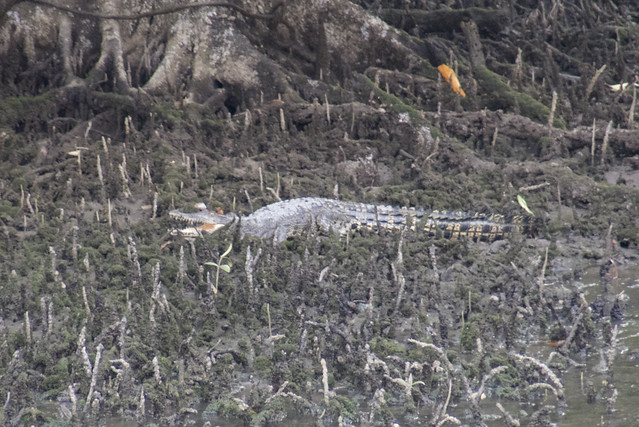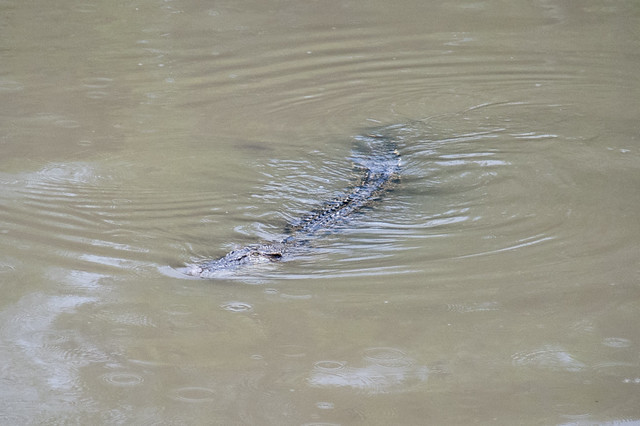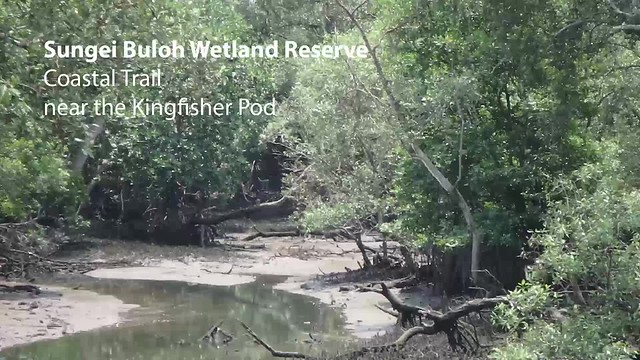What do crocodiles eat? And where can we see them in Singapore?
We often don't even see the crocodile when it's right in front of us.
Then if we see something, is that indeed a crocodile? Often, large Malayan water monitor lizards are mistaken for crocodiles. Our monitor lizards can grow to 2m or longer. While in the water, the lizard often swims by placing its limbs against its body and undulating its long tail from side to side. Its snout is short and narrow, and tail is long and slender.
A crocodile has a long snout and a much thicker fatter tail. It may swim in the same way as the monitor lizard. It may also often sink into the murky water and emerge some distance away. Sometimes, all that sticks out above water are the crocodile's eyes and the tip of its long snout.
On land, a large monitor lizard can look scary and be mistaken for a crocodile! Once again, observe that the monitor lizard has a short snout and slender tail. And the monitor lizard has a long blue forked tongue which it regularly flicks out now and then. The crocodile doesn't have such a tongue.
A crocodile on the other hand, has a long snout and jaws full of teeth! And a thick fat tail. Its scales are also much bigger.
Here's about how ordinary monitor lizards are mistakenly identified as all kinds of animals that don't even occur naturally in Singapore.
So it IS a crocodile! What should I do?!Here's about how ordinary monitor lizards are mistakenly identified as all kinds of animals that don't even occur naturally in Singapore.
Admire this magnificent creature, from a distance. Among the things a crocodile might be seen doing is simply lying in the sun. It does this to warm up. Sometimes, it might have its mouth wide open, which is how a crocodile tries to cool down on a hot day (much like the way a dog pants). It's not doing this to show aggression or to get ready to bite.
Here's another cool thing they do: this small crocodile is splashing mud on itself probably to cool off from the heat.
If we are patient, we may observe a crocodile hunting! Crocodiles usually hunt while submerged in water, stealthily swimming slowly. Here's a video of a crocodile on the hunt.
Often, crocodiles just lie motionless, pretending to be a harmless log. This is also why it is important to stay on the path and not go into the water.
What do crocodiles eat?
Crocodiles are awesome predators that eat all kinds of animals. Small crocodiles may eat insects, frogs, crabs and fishes. Adults can eat larger prey including fish, birds and mammals, hunting mainly at night. They may also eat dead animals. Despite our worst fears, crocodiles don't eat people.
Where can we spot crocodiles?
In the past, crocodiles were common even in the Singapore River, Kallang River, Sungei Seletar and Kranji Reservoir, and Pulau Tekong. They are no longer common and are now considered Critically Endangered.
The best place to spot crocodiles nowadays is at Sungei Buloh Wetland Reserve. Large awesome crocodiles are most often seen near the Main Bridge especially at lowish tides. Smaller ones are also seen in the mangroves off Kingfisher Bridge.
The prominent triangular "Watch It" signs posted all over the Reserve tells you where you might spot crocodiles. So stop and have a good look around.
What should I do if a crocodile is real close?
Like any wild animal, crocodiles will not harm humans if they are not disturbed or threatened, and if we keep a respectful distance from them.
 |
| This large crocodile photographed by Richard Seah and reported in the media, started a conversation about crocodiles. |
- Stay on desinated paths, don't get into the water.
- If a crocodile is spotted on the path, stay calm and back away slowly.
- Do not approach, provoke or feed the crocodile.
NParks has sensible advice on "What to do if you spot an Estuarine Crocodile?"
Die die I want to see the crocodiles at Sungei Buloh!
The best chance to spot a crocodile is to go with a nature guide. Join the 21 Jan (Sun) walk at Sungei Buloh by experts of the Herpetological Society of Singapore! These young naturalists love reptiles (and amphibians) and would be delighted to show you the crocodiles and wildllife of the Reserve.
There are also free guided walks every Saturday at the Reserve, as well as many other exciting nature happenings there. Another way to get close to the crocodiles and wildlife of the Reserve is to volunteer with them. More details by NParks.
Crocodiles are magnificent jewels that crown the mangroves and wetlands of Singapore! Smile when you see them!
Share YOUR sighting of a crocodile on Singapore shores!
More about crocodiles
Die die I want to see the crocodiles at Sungei Buloh!
The best chance to spot a crocodile is to go with a nature guide. Join the 21 Jan (Sun) walk at Sungei Buloh by experts of the Herpetological Society of Singapore! These young naturalists love reptiles (and amphibians) and would be delighted to show you the crocodiles and wildllife of the Reserve.
There are also free guided walks every Saturday at the Reserve, as well as many other exciting nature happenings there. Another way to get close to the crocodiles and wildlife of the Reserve is to volunteer with them. More details by NParks.
 |
| Crocodile under the Main Bridge at Sungei Buloh. |
Crocodiles are magnificent jewels that crown the mangroves and wetlands of Singapore! Smile when you see them!
Share YOUR sighting of a crocodile on Singapore shores!
More about crocodiles
- Crocodile! What should I do?! on the wild shores of singapore blog
- Crocodiles in Singapore on the wildsingapore fact sheets
- Estuarine crocodiles and what to do if you encounter one by NParks.
- Malayan water monitor lizards in Singapore on the wildsingapore fact sheets.
- Busting Myths about Monitors by Ivan Kwan on the Celebrating Singapore's Biodiversity blog.













